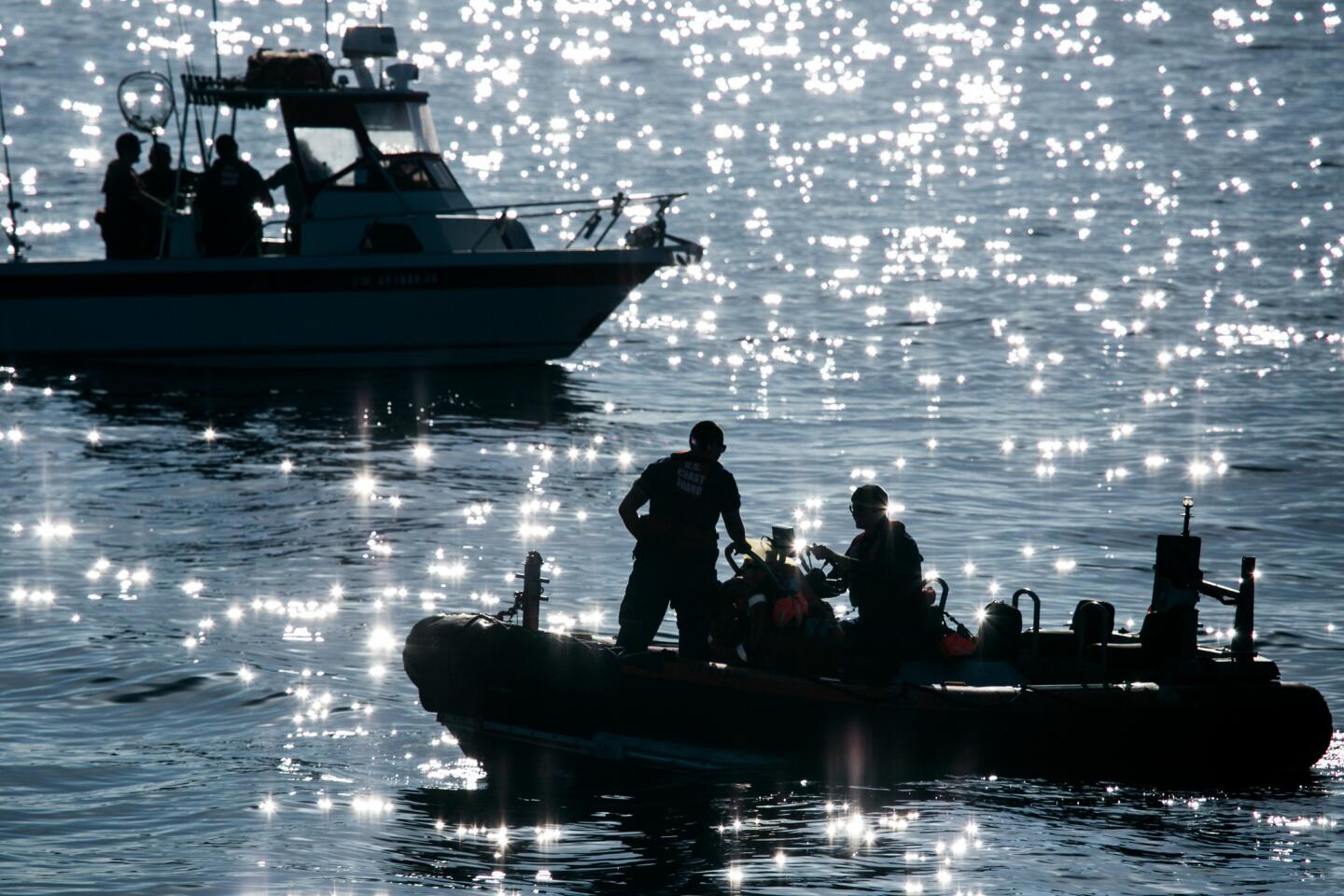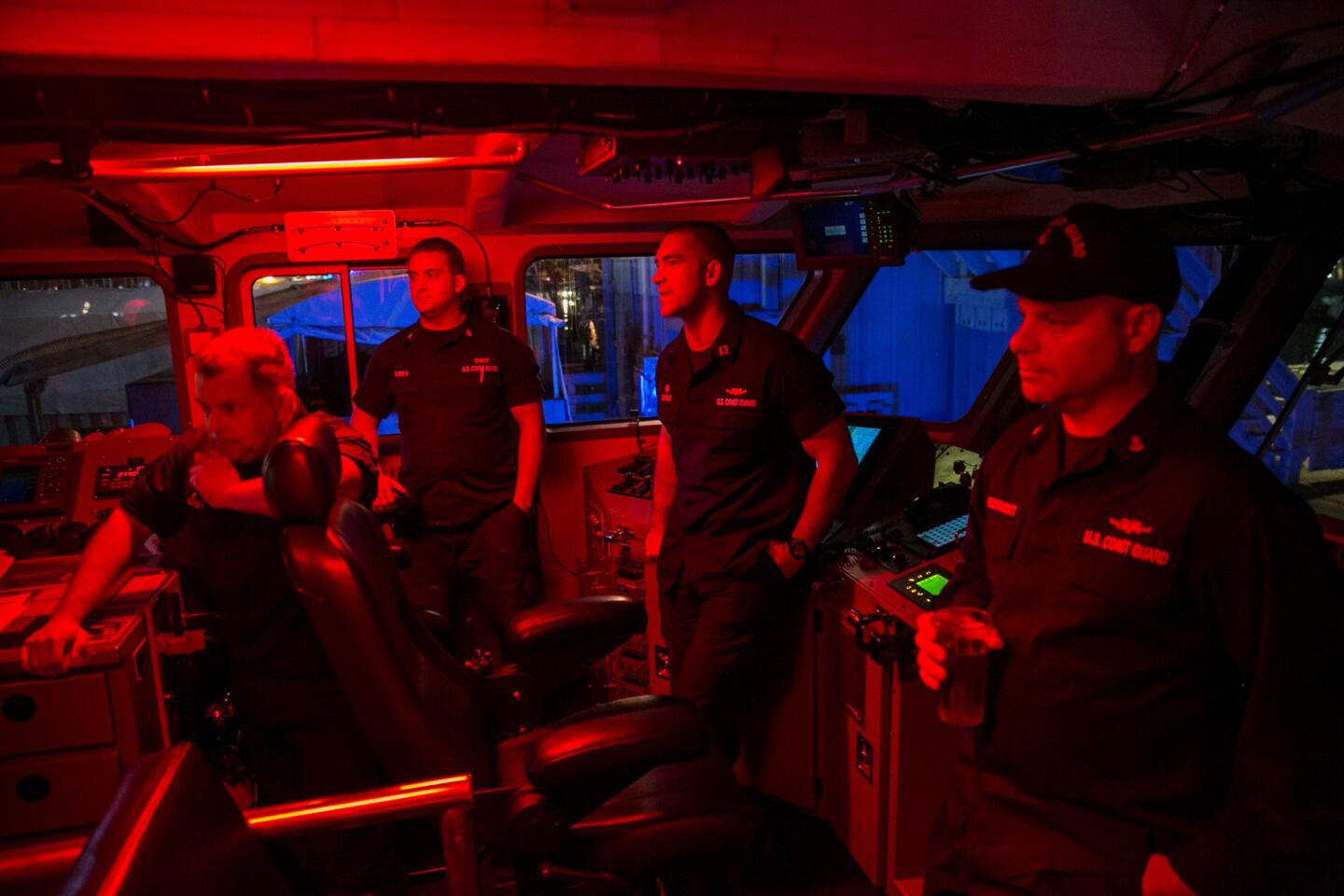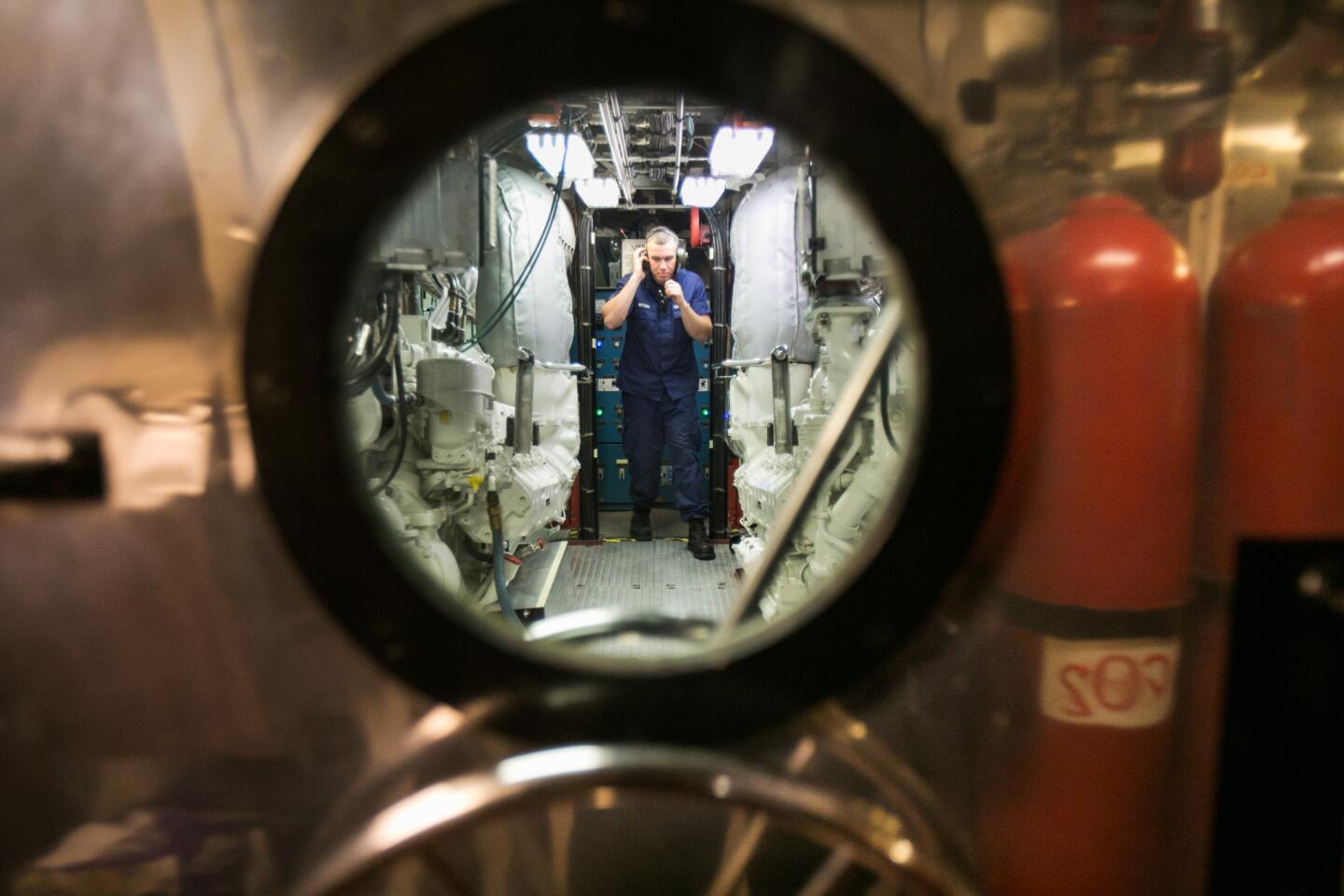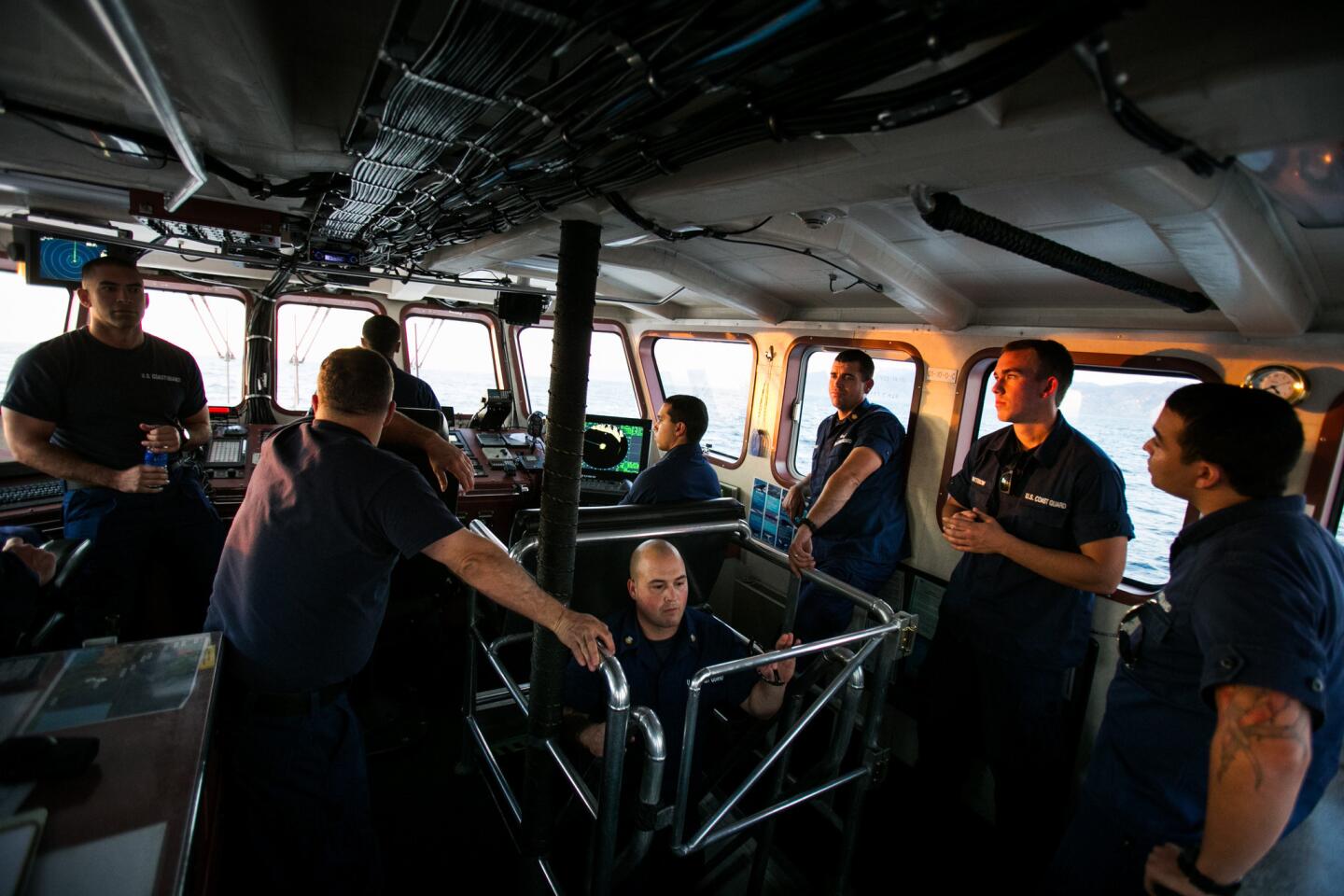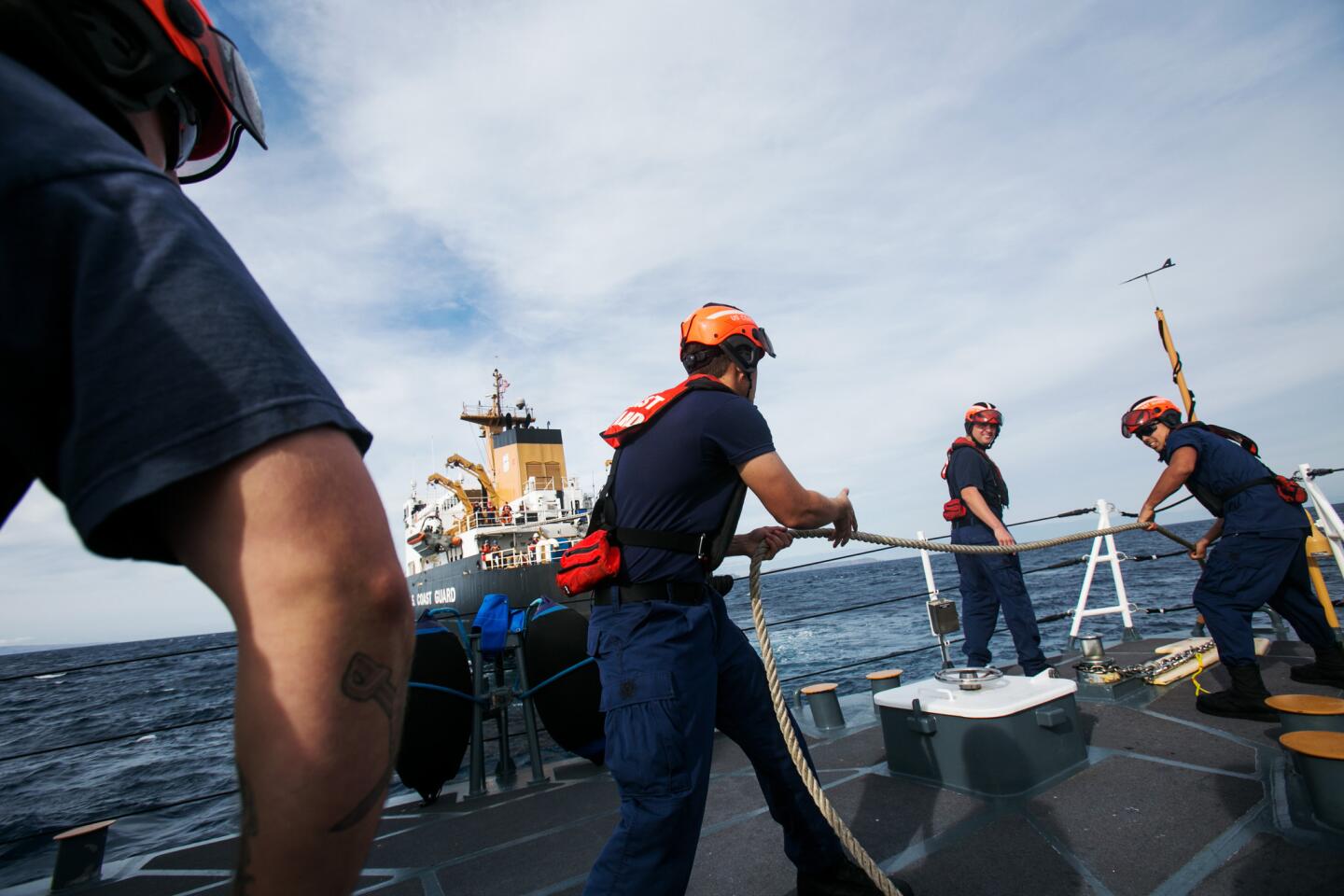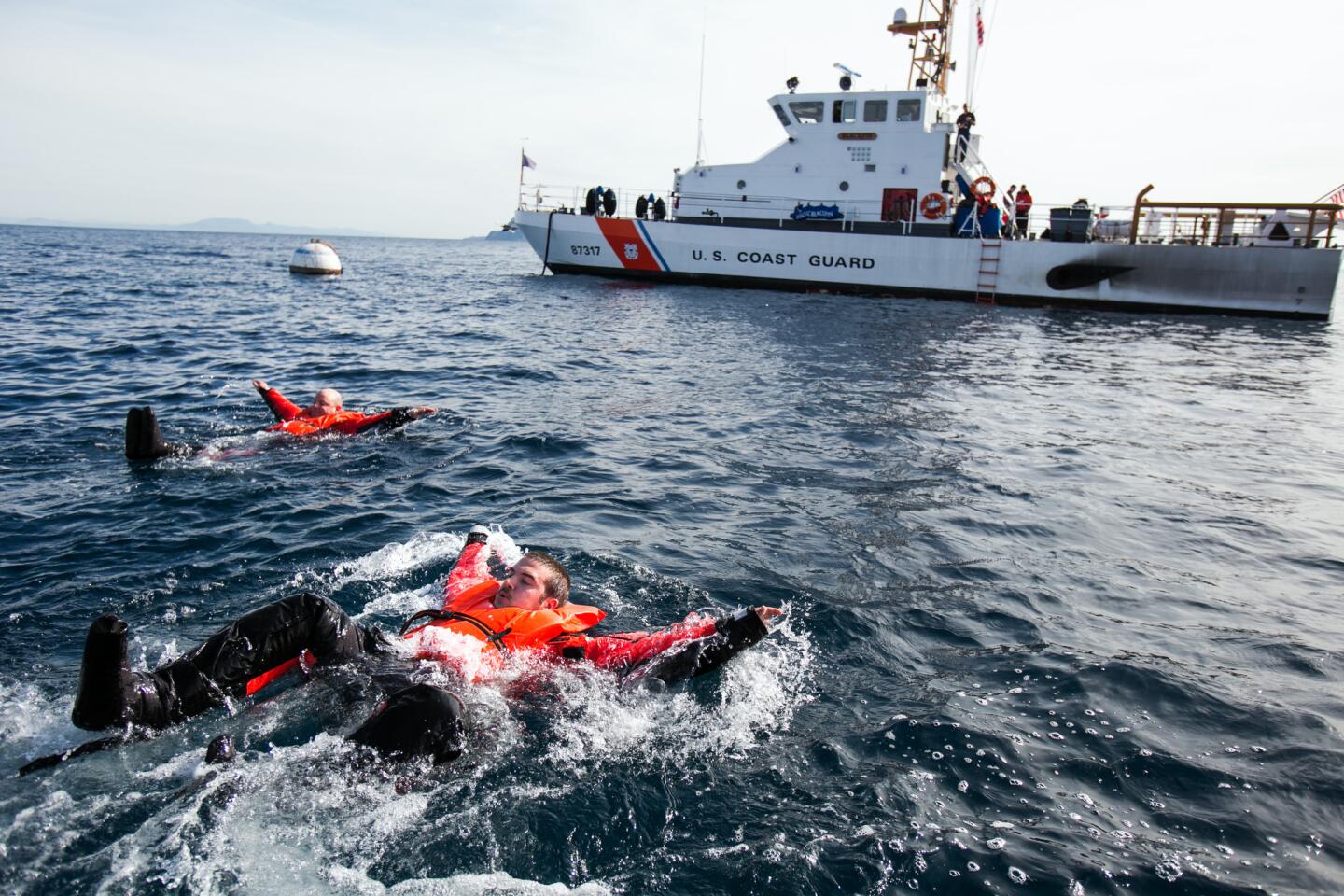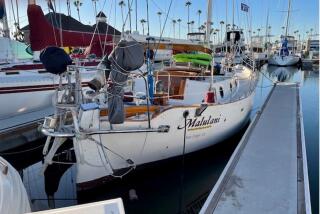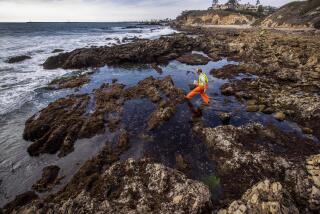Great Read: Hunting for smugglers — of drugs and humans — off California’s coast
John Babbini’s words were hard to hear over the noise of the boat’s propellers churning the water, so he leaned back and talked over his right shoulder.
“We’re going to have to watch ‘Master and Commander’ later,” he bellowed in a thick New Jersey accent. “It’s my favorite movie out at sea.”
His back stiff, his stance wide for balance, Babbini shifted his eyes forward and down to where his flashlight was aimed, about 100 feet beyond the deck of the Coast Guard cutter Blackfin. On this Friday evening, the first class petty officer was helping guide the boat around crab traps bobbing in Santa Barbara Harbor’s darkened waters.
The sun had set. The ocean turned gun-metal gray under the light of a full moon. The 10-man crew began the slow push off the coast to begin its two-day mission: to hunt for smugglers.
But this was the kind of hunt that required patience.
::
The 87-foot-long Blackfin patrols from Morro Bay to Dana Point, an expanse of water increasingly coming into play for traffickers — of humans and drugs — who hope to avoid the federal government’s squeeze on traditional land routes.
Since 2011, more than 340,000 pounds of marijuana and 1,900 migrants have been seized off the California coast.
To avoid the Coast Guard’s wide net, traffickers have taken to motoring as far as 100 miles off the Mexican coast before turning north toward the United States, said Lt. David Zwirblis, the Blackfin’s captain.
In 2012, Chief Petty Officer Terrell Horne III was killed when traffickers in a panga boat rammed the small, inflatable craft Horne was piloting off the Santa Barbara coast. It was the first such killing of a Coast Guard member in 90 years. Earlier this week, the Coast Guard announced that one of its aircraft fired on a panga boat off the Southern California coast during an interdiction for the first time.
“Everyone associates the Coast Guard with search and rescue … but most of it is law enforcement,” said Zwirblis, 26, perhaps the most ambitious of the group in building a career.
After graduating from the Coast Guard Academy, Zwirblis got a plum assignment patrolling waters off Bahrain during the Iraq war. Afterward, he was shipped to Southern California and got his first command with the Blackfin.
On patrol this weekend,the Blackfin crew was preoccupied with the routine — policing protected waters for illegal fishing, watching for boaters in need of rescue, and doing boat maintenance and paperwork.
Not everyone on board has been involved in a daring rescue or tense standoff with a drug runner —- the Blackfin’s last interdiction was a year ago.
As the crew waits for another big moment, seafaring epics such as “Master and Commander” — with its scenes of swashbuckling heroes chasing knaves and other assorted villains — break up the routine of life at sea. Over the weekend, the Blackfin crew would watch the Russell Crowe film about Napoleonic naval warfare no less than four times.
The arcane language is part of the crew’s vocabulary. At one point, Crowe’s character orders the crew to prepare the starboard “battery,” or a ship’s armament.
“See when he said, ‘Prepare the battery?’ We still say that,” Babbini said before tossing out a reference to the Coast Guard’s founding in 1790 under Alexander Hamilton. “Occasionally, we’ll do things the way they did way back when they were still around.” (At least once over the weekend, a Blackfin crew member will be called a “scalawag.”)
::
The sun was disappearing over the horizon Saturday when Zwirblis got on the ship’s intercom and called the crew to the bridge. The men solemnly went through their safety checks and Zwirblis told four of them to head below deck to get bulletproof vests and guns.
Their panga interdiction drill was about to begin.
Hundreds of yards away, a smaller Coast Guard boat waited in the water; its crew would be the smugglers. The reports started to flow rapidly over the radio: “Panga boat spotted.” “Assistance requested.” “It’s dropped its cargo in the water.”
The Blackfin’s engines roared to life. The 14-year-old boat can cut through the water at nearly 30 mph but gulps 160 gallons of fuel an hour at that speed, so fuel conservation is always in the back of Zwirblis’ mind.
As the boat chugged toward the panga, four crew members hopped into the small, inflatable boat in the ship’s stern and took off after it. Armed with plastic guns in this drill, the crew members pulled alongside their target just as a Coast Guard helicopter arrived.
It swooped down and whitened the target in its spotlight; the chopper carries a sniper who can train his rifle on a boat’s engine if smugglers refuse to stop. Crew members can also toss a net in the water to get tangled in its propellers — like a police spike strip on water.
Zwirblis piloted the Blackfin in the panga’s wake to tag dumped cargo — usually bales of marijuana — with illuminated markers so they could get picked up later.
In less than an hour, the drill was finished. The smugglers were “captured,” the “drugs” were picked up, and the Blackfin returned to its patrol.
::
It was 4:30 a.m. on the last day at sea, and the bridge of the Blackfin was bathed in a bloody glow from the lighting used for covert patrols. Gregorian chants were playing over the radio. On the ship’s night-vision camera, the empty sea stretched forever.
Manning the bridge overnight can be a lonely job, just two men sitting in the darkness with their thoughts, but Chief Petty Officer Jim McDermott is used to the isolation. The New York native spent summers duck hunting in Long Island’s soggy wetlands.
He is soft-spoken with narrow eyes and chews tobacco. McDermott earned a degree in criminal justice and wanted to be a police officer, but said after he was twice rescued in the wetlands by the Coast Guard, he wanted a career on the water where he was doing the saving instead of the one being saved.
A few hours later, after breakfast, the crew joined rookie Thomas Mattison on deck. All but a handful of crew members took turns piling on four layers of material before jumping into the warm Pacific waters. If it were the dead of winter off the coast somewhere colder, those layers would save their lives.
The clothing is meant for the types of conditions Babbini remembers fondly. During his first assignment in Jones Beach on Long Island, Babbini and his crew were hailed in the middle of the night to pull boaters from a sinking vessel 30 miles off the coast.
“You’re in that cold, you feel that spray coming on you, you see that vessel that’s in distress and you’re in 8- to 10-foot seas with 30-knot wind,” Babbini said with excited eyes and a grin. “They’ll ask you, ‘OK, Babbini! You’re on line one, the primary line,’ and you got to get that line over to that boat. You are the lifeline.”
Babbini fell in love with the Coast Guard visiting the red-roofed station on the Jersey Shore as a kid. He applied to patrol in the Middle East during the war but wasn’t selected and hopes to move back to the East Coast for his next assignment this summer.
Ironically, Babbini is prone to seasickness. Sometimes, he sleeps on the bottom deck because it limits the swaying. On the first night of the latest voyage, he went to the shelves next to the TV and grabbed his favorite movie so he could watch it in bed until he fell asleep.
“Dang it! It’s Blu-ray!” he said. He didn’t have a Blu-ray player.
He put “Master and Commander” back in its spot on the shelf.
::
The next morning, a handful of crew members crowded into the boat’s dining area, a 15-foot by 20-foot space with two tables between the engine room in the rear and a passageway leading to two sleeping quarters at the front. There were omelets, pancakes and cereal; “Duckmen 17: The Reckoning,” was playing on the boat’s big flat-screen TV.
The Robertson family is better known for the “Duck Dynasty” reality show on A&E, but Christmas hunting specials like this one go back to when McDermott was a teenager, he said.
As the Robertsons lay waste to unsuspecting fowl on screen, someone asked, “Who would you rather shoot: Daffy Duck, or Donald Duck?” to no one in particular.
Some quiet deliberations ensued, and a verdict was reached.
“I’d shoot Daffy, because Donald’s cool,” Petty Officer 2nd Class Parker Dawson said.
And as Babbini pointed out, “Donald’s got a sailor suit.”
After the last of the weekend training — a boat-towing exercise with a 225-foot Coast Guard ship — the Blackfin returned to Santa Barbara Harbor. It was an easy weekend by all accounts, especially compared to the one before, when the crew had rolled among 8-foot swells in a powerful winter storm.
After the Blackfin’s lines were secured to cleats on the dock, the crew disappeared below deck for one final meal together as the sun set.
Twitter: @JosephSerna
More to Read
Start your day right
Sign up for Essential California for news, features and recommendations from the L.A. Times and beyond in your inbox six days a week.
You may occasionally receive promotional content from the Los Angeles Times.
